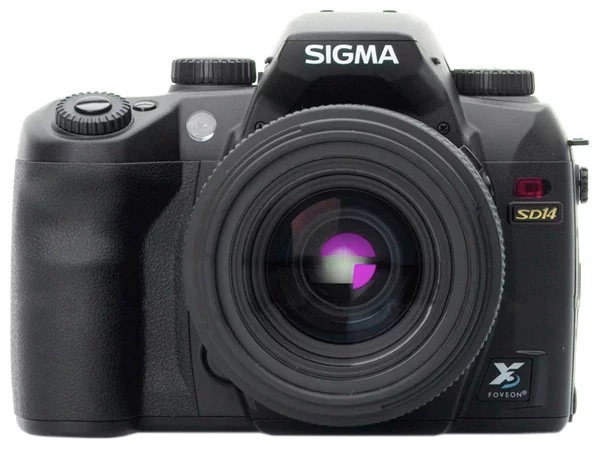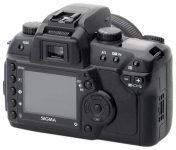Announced
Production status
System
Sigma SA APS-C system cameras
Sigma SD14
APS-C AF digital SLR camera • Discontinued
Specification
| Format: | |
| APS-C | |
Imaging sensor: | 20.7 × 13.8mm Foveon X3 CMOS sensor |
Resolution: | 2640 × 1760 - 5 MP |
Crop factor: | 1.74x |
Sensor-shift image stabilization: | - |
| Sigma SA [44mm] | |
| Shutter: | |
Type: | Focal-plane |
Model: | Electronically controlled |
Speeds: | 30 - 1/4000 + B |
| Exposure: | |
Exposure metering: | Through-the-lens (TTL), open-aperture |
Exposure modes: | Programmed Auto |
| Aperture-priority Auto | |
| Shutter-priority Auto | |
| Manual | |
| Physical characteristics: | |
Weight: | 700g |
Dimensions: | 144x107.3x80.5mm |
Manufacturer description
The Sigma Corporation is pleased to announce the launch of the new Sigma SD14 Digital SLR camera.
The new SD14, powered by the 14 megapixel Foveon X3® direct-image-sensor, can reproduce high definition images rich in gradation and impressive three-dimensional detail.
The SD14 Digital SLR camera features four JPEG recording modes, a large and bright pentaprism viewfinder with 98% coverage, a built-in flash with a Guide Number of 11, 5-point AF system, a large 2.5” 150,000 pixel resolution LCD monitor as well as a new user friendly design. The durable shutter mechanism has over 100,000-cycle life and is ideal for the demands of digital photography.
Development
Sigma introduced its first digital SLR camera, the SD9, to the market in October 2002, and has established strong support from a wide range of photographers both amateur and professional alike. The second model, the SD10, released on to the market in November 2003 continued to build on the support of loyal photographers. However, demand for JPEG’s greater convenience in image handling has increased and in order to meet this demand the new SD14, powered by Foveon X3® direct image sensor, now includes JPEG mode with high image quality, high performance and versatility.
Product Summary
14 megapixels Foveon X3® direct image sensor
The Foveon X3® direct image sensor featured in the Sigma SD14 digital SLR can capture all primary RGB colours at each and every pixel arranged in three layers, insuring the capture of full and complete colour. Using three silicon-embedded layers of photo detectors, stacked to take advantage of silicon’s ability to absorb red, green, and blue light at different respective depths, it efficiently reproduces colour more accurately and offers sharper resolution, pixel for pixel, than any conventional image sensor.
Until now, all other image sensors have featured a just single layer of pixels and each pixel captures only one colour of light, which has been filtered through a single colour filter. Since mosaic-based conventional image sensors capture only one-third of the colour, complicated computations are required to interpolate the colours they miss. Interpolation leads to colour errors, colour artifacts and a loss of image detail. Low pass filters must then be used to reduce colour artifacts. The use of low pass filters adversely affect sharpness and resolution of the final image captured.
* Foveon X3 is the registered trademark of Foveon.
In-camera JPEG mode offers added convenience
The SIGMA SD14 incorporates both RAW and JPEG image recording formats enabling photographers to capture the highest possible picture definition and small file sizes. JPEG recording, also built into the SD14, can be used for the following printing sizes;
- Super High (14.15 million pixels: 4608×3072 pixels) can be used for A3 (297x420mm/11.6"x16.5") or larger prints.
- High (4.64 million pixels: 2640×1760 pixels) for A4 size (210x297mm/8.2"x11.6") printing.
- Medium (2.1 million pixels: 1776×1184 pixels) can be used for regular size printing.
- Low (1.03 million pixels: 1296×864 pixels) can be used for web-page and e-mail transmission.
There is a choice of three JPEG quality settings: Fine, Normal and Basic.
Versatile and easy to use SIGMA Photo Pro 3.0 exclusive software, supplied with the SD14
The SD14 comes complete with SIGMA Photo Pro 3.0 software, a RAW image developer that converts all RAW data quickly and easily. Adjustments can be made in three separate modes. The X3F Mode stores the original settings of the image at the point of capture. In the Auto Adjustment Mode, the software analyses and automatically makes adjustments to the RAW data. The Custom Mode allows the photographer to make individual adjustments (exposure, contrast, shadow, highlight, saturation, sharpness and fill-light for example). The photographer can make subtle or dramatic changes easily and quickly by simply adjusting the slider controls within the software.
The X3F Mode stores the original settings of the image at point of capture. Photographers` personal modifications can be saved to the RAW, X3F file for future use.
SIGMA Photo Pro 3.0 supports 8-bit TIFF, 16-bit TIFF, and JPEG file formats and also outputs images in sRGB, Apple RGB, Adobe RGB and ColourMatch RGB colour spaces. The default setting for output resolution is the same as the resolution selected when capturing the image on the camera (High, Medium, or Low). It is also possible to half, (for sending via e-mails) or double (for high quality enlargements, max. 18.58 million pixels: 5,280 × 3,520 pixels)the resolution when processing the image.
Image Sensor Dust Protector
Most digital SLR cameras are typically vulnerable to dust entering the body especially when the lens is removed for changing. Dust and dirt entering through the lens mount of a digital camera can be seriously detrimental to image quality. The dust protector of the SIGMA SD14 prevents dust from entering and adhering to the image sensor. Even if dust adheres to the dust protector it will not have an adverse influence on image quality as the dust protector is located away from the image sensor and is therefore out of focus.
Large and bright pentaprism viewfinder
The SD14 is equipped with a newly developed pentaprism viewfinder, which has 98% (vertical and horizontal) coverage with 0.9x magnification, an 18mm eye point and –3 to +1.5 dpt dioptric adjustment.
Large 2.5” LCD monitor
The SD14 camera features a new, large 2.5 inch, 150,000 pixel resolution LCD monitor. The LCD monitor displays 100% of the image, allowing the photographer to easily and accurately confirm the image composition. It features playback options including single frame, thumbnail display (9 images), and three types of magnification (which is achieved by use of the 4-way controller). Shutter speed, aperture and other settings can be seen by pressing the INFO button. The large menu interface makes reviewing images and navigating menu options easy.
Reliable and Durable Shutter
The durable focal plane shutter mechanism has life cycle of over 100,000 exposures. The shutter is ideally suited to the requirements of digital cameras. This new shutter dramatically reduces the amount of dust and dirt from the shutter mechanism. The photographer can enjoy taking pictures without worrying about dirt and dust adhering to the image sensor either from inside or outside the camera.
Fast and precise focusing with 5-point AF
The new auto focus sensor features 5 focusing points (center, left, right, up and down) ensuring consistently fast and precise focusing. The AF metering features a cross type sensor in the center of the screen. Selecting the AF point can be done automatically or manually by photographer.
High speed continuous shooting
The SD14 features a continuous shooting speed of 3 frames per second. Continuous shooting can be accomplished in conjunction with the camera’s predictive auto focus function when photographing fast moving subjects. The camera’s high-speed image processing circuits are capable of handling large data files generated by the high-resolution 14 megapixel sensor. The number of images that can be captured in continuous shooting mode is dependent upon the resolution setting; High - 6 frames, Medium - 12 frames and Low - 24 frames. These figures apply in either RAW or JPEG mode.
Built-in Flash
The Sigma SD14 camera’s built-in flash offers an angle of coverage of 17mm (equivalent to 28mm with 35mm full size) lens with a guide number of 11 (ISO 100). Built-in flash can be synchronized to a shutter speed up to 1/180 sec. This built-in flash enables automatic S-TTL shooting, which allows simple, easy control of advanced photography techniques.
Easy to use multifunction interface
The new layout of control buttons insures quick identification of the desired functions and easy use of the multifunction interface in operating camera settings. Clearly marked buttons make it easy for the photographer to display and adjust the most important settings, namely ISO, resolution, JPEG quality and file type, and white balance on one screen, using one button. The top LCD panel incorporates a backlight, which enables the camera to be easily controlled in low light or dark conditions.
Mirror lock-up mechanism prevents camera shake
The mirror lock-up mechanism raises the mirror thus preventing vibration when the shutter is released. This prevents camera shake, and is especially effective for macro photography, using extremely long telephoto lenses or scientific work. Use of a remote controller (sold separately) or cable release (sold separately) also reduces the possibility of camera shake.
Three types of metering mode
The Sigma SD14 is equipped with three types of metering mode: 8-segment Evaluative Metering, Center Area Metering and Center Weighted Average Metering. This enables the photographer to select the metering mode depending on subject and situation. Exposure compensation function allows the photographer to override the exposure value set by the camera’s exposure meter.
Auto Bracketing function allows the exposure to be adjusted by 1/3 EV increments up to ±3 EV from the exposure automatically set by the camera. In situations where it is difficult to determine proper exposure, the auto bracketing function allows a sequence of pictures to be taken of the same subject at three different exposure levels; Appropriate Exposure, Under Exposure and Over Exposure.
Power Source
The Lithium-ion Battery BP-21 (included with the camera) can shoot approximately 500 images on one full charge. It takes about 120 minutes to fully charge with Battery Charger BC-21 (also included). The optional power grip PG-21 has a vertical shutter release button and can hold two BP-21 batteries, supplying more than enough power for most shoots. The AC Adapter SAC-21 (sold separately) enables the Sigma SD14 to obtain power from the mains supply.
The top LCD panel
The top LCD panel allows the photographer to quickly and accurately confirm information such as resolution setting, metering mode, battery status, and the number of images that can be recorded on the CF card. It also incorporates an orange backlight which enables the camera to be easily controlled in low light or dark conditions.
Optional accessories
The SD14 can be used with over 40 Sigma lenses such as ultra-wide, ultra-telephoto, macro, and fisheye. The EF-500 DG SUPER, EF-500 DG ST, and EM-140 DG flashguns offer fully automatic S-TTL flash dedication. Other accessories include the power grip (PG-21), cable release (CR-21), remote controller (RS-31) and the AC adaptor (SAC-21). These accessories ensure that the SD14 system is both user-friendly and versatile.

